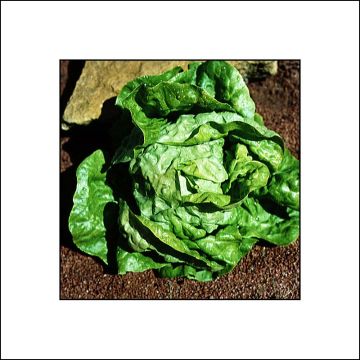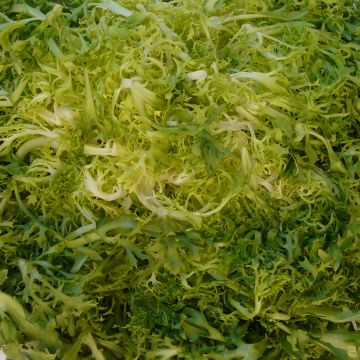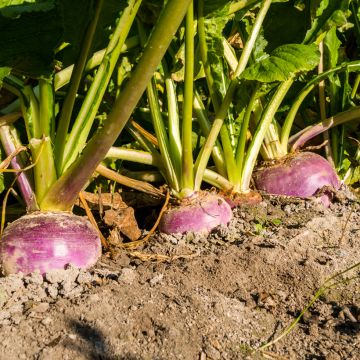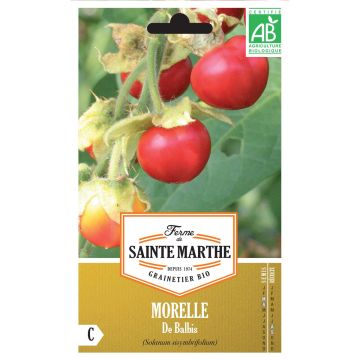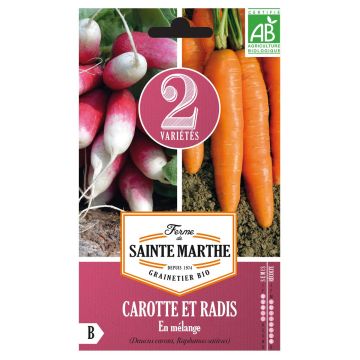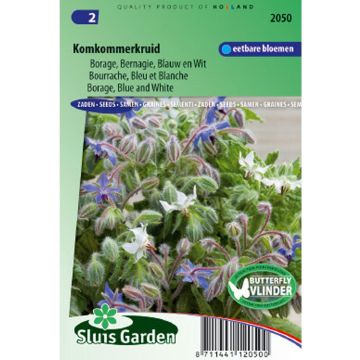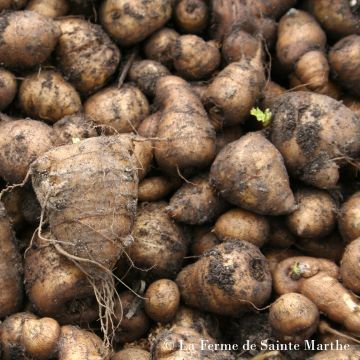

Winter Lettuce Val d'Orge - Lactuca sativa
Winter Lettuce Val d'Orge - Lactuca sativa
Lactuca sativa Val d'Orge
Lettuce
This item cannot be shipped to the selected country
Dispatch by letter from €3.90
More information
Schedule delivery date,
and select date in basket
This plant carries a 6 months recovery warranty
More information
We guarantee the quality of our plants for a full growing cycle, and will replace at our expense any plant that fails to recover under normal climatic and planting conditions.
Seed-only orders are dispatched by sealed envelope. The delivery charge for seed-only orders is €3.90.
Description
Lactuca sativa 'Val d'Orge' is a highly cold-resistant winter lettuce. It forms voluminous, moderately tight heads composed of large smooth, blonde-green leaves. This hardy variety can be sown from August to October for a harvest from March to May.
Lettuce is one of the most popular salad vegetables (with a consumption of 4.2 kilograms per person per year). It is equally appreciated for its freshness, crispness, its taste, and nutritional qualities. It can be consumed raw in salads, but also cooked, to accompany peas, for example.
As the ultimate leafy vegetable, lettuce is an annual plant belonging to the large Asteraceae family. Its Latin name, Lactuca sativa, refers both to the white sap (lactuca) that oozes when it is cut and to the fact that it is cultivated (sativa).
It is an important part of any respectable vegetable garden, and there are so many varieties that it can be cultivated almost all year round. Winter lettuces are hardy and resistant to the cold. Their development is slower than summer lettuces, so they should be sown in late summer/early autumn for a spring harvest.
Lettuce cultivation is easy as long as the cultivation calendar for each variety is respected. Its growth is fast, and it thrives in any soil that is rich and remains moist.
Harvest: cut with a knife when it reaches maturity.
Storage: lettuce can be stored for a few days in the refrigerator, but to fully enjoy its freshness, we recommend consuming it immediately after harvesting. It is also possible to freeze cooked lettuce.
Gardener's tip: slugs and snails are a nightmare for gardeners as they love lettuce leaves. You can try to prevent them with ashes (which are quickly washed away by rain), a homemade beer trap (which is harmful to hedgehogs), or copper strips that are supposed to electrocute them, but do not seem to work. Instead of wasting time with these methods, use an anti-slug product composed of ferric phosphate known as Ferramol. Unlike slug pellets based on metaldehyde, which are dangerous for wildlife and polluting, Ferramol is natural, non-toxic, and very effective as long as you remember to "treat" your plot a few days before sowing.
Report an error about the product description
Harvest
Plant habit
Foliage
Botanical data
Lactuca
sativa
Val d'Orge
Asteraceae
Lettuce
Cultivar or hybrid
Annual
Other Salad leaf seeds
Planting and care
Sowing
The germination of winter lettuce occurs at fairly low temperatures, around 12 to 15°C (53.6 to 59°F), and takes an average of 10 days.
Sow from August to October for a harvest from March to May.
Loosen and prepare the soil well. Trace furrows spaced 40cm (16in) apart, with a depth of 0.5cm. Sow in rows, spacing the seeds 4cm (2in) apart and cover them. When the plants are developed, thin them out to leave one plant every 40cm (16in).
Cultivation
Lettuce is not very demanding, but it still requires humus-rich soil, otherwise it tends to bolt prematurely. It is wise to apply a moderate amount of mature compost to the soil in autumn. Loosen the soil and hoe the well-rotted compost in to a depth of 5cm (2in). It prefers slightly acidic to neutral soils (pH between 5.5 and 7.5).
Lettuce likes moist soils so water it regularly.
During cultivation, remember that lettuce prefers moist soil, so mulch around the plants. Lettuce is a good companion plant. It easily intercrops with other slower-growing vegetables such as beans, tomatoes, and cucumbers. Just avoid planting it next to corn.
Seedlings
Care
Intended location
This item has not been reviewed yet - be the first to leave a review about it.
Vegetable seeds
Haven't found what you were looking for?
Hardiness is the lowest winter temperature a plant can endure without suffering serious damage or even dying. However, hardiness is affected by location (a sheltered area, such as a patio), protection (winter cover) and soil type (hardiness is improved by well-drained soil).

Photo Sharing Terms & Conditions
In order to encourage gardeners to interact and share their experiences, Promesse de fleurs offers various media enabling content to be uploaded onto its Site - in particular via the ‘Photo sharing’ module.
The User agrees to refrain from:
- Posting any content that is illegal, prejudicial, insulting, racist, inciteful to hatred, revisionist, contrary to public decency, that infringes on privacy or on the privacy rights of third parties, in particular the publicity rights of persons and goods, intellectual property rights, or the right to privacy.
- Submitting content on behalf of a third party;
- Impersonate the identity of a third party and/or publish any personal information about a third party;
In general, the User undertakes to refrain from any unethical behaviour.
All Content (in particular text, comments, files, images, photos, videos, creative works, etc.), which may be subject to property or intellectual property rights, image or other private rights, shall remain the property of the User, subject to the limited rights granted by the terms of the licence granted by Promesse de fleurs as stated below. Users are at liberty to publish or not to publish such Content on the Site, notably via the ‘Photo Sharing’ facility, and accept that this Content shall be made public and freely accessible, notably on the Internet.
Users further acknowledge, undertake to have ,and guarantee that they hold all necessary rights and permissions to publish such material on the Site, in particular with regard to the legislation in force pertaining to any privacy, property, intellectual property, image, or contractual rights, or rights of any other nature. By publishing such Content on the Site, Users acknowledge accepting full liability as publishers of the Content within the meaning of the law, and grant Promesse de fleurs, free of charge, an inclusive, worldwide licence for the said Content for the entire duration of its publication, including all reproduction, representation, up/downloading, displaying, performing, transmission, and storage rights.
Users also grant permission for their name to be linked to the Content and accept that this link may not always be made available.
By engaging in posting material, Users consent to their Content becoming automatically accessible on the Internet, in particular on other sites and/or blogs and/or web pages of the Promesse de fleurs site, including in particular social pages and the Promesse de fleurs catalogue.
Users may secure the removal of entrusted content free of charge by issuing a simple request via our contact form.
The flowering period indicated on our website applies to countries and regions located in USDA zone 8 (France, the United Kingdom, Ireland, the Netherlands, etc.)
It will vary according to where you live:
- In zones 9 to 10 (Italy, Spain, Greece, etc.), flowering will occur about 2 to 4 weeks earlier.
- In zones 6 to 7 (Germany, Poland, Slovenia, and lower mountainous regions), flowering will be delayed by 2 to 3 weeks.
- In zone 5 (Central Europe, Scandinavia), blooming will be delayed by 3 to 5 weeks.
In temperate climates, pruning of spring-flowering shrubs (forsythia, spireas, etc.) should be done just after flowering.
Pruning of summer-flowering shrubs (Indian Lilac, Perovskia, etc.) can be done in winter or spring.
In cold regions as well as with frost-sensitive plants, avoid pruning too early when severe frosts may still occur.
The planting period indicated on our website applies to countries and regions located in USDA zone 8 (France, United Kingdom, Ireland, Netherlands).
It will vary according to where you live:
- In Mediterranean zones (Marseille, Madrid, Milan, etc.), autumn and winter are the best planting periods.
- In continental zones (Strasbourg, Munich, Vienna, etc.), delay planting by 2 to 3 weeks in spring and bring it forward by 2 to 4 weeks in autumn.
- In mountainous regions (the Alps, Pyrenees, Carpathians, etc.), it is best to plant in late spring (May-June) or late summer (August-September).
The harvesting period indicated on our website applies to countries and regions in USDA zone 8 (France, England, Ireland, the Netherlands).
In colder areas (Scandinavia, Poland, Austria...) fruit and vegetable harvests are likely to be delayed by 3-4 weeks.
In warmer areas (Italy, Spain, Greece, etc.), harvesting will probably take place earlier, depending on weather conditions.
The sowing periods indicated on our website apply to countries and regions within USDA Zone 8 (France, UK, Ireland, Netherlands).
In colder areas (Scandinavia, Poland, Austria...), delay any outdoor sowing by 3-4 weeks, or sow under glass.
In warmer climes (Italy, Spain, Greece, etc.), bring outdoor sowing forward by a few weeks.

































